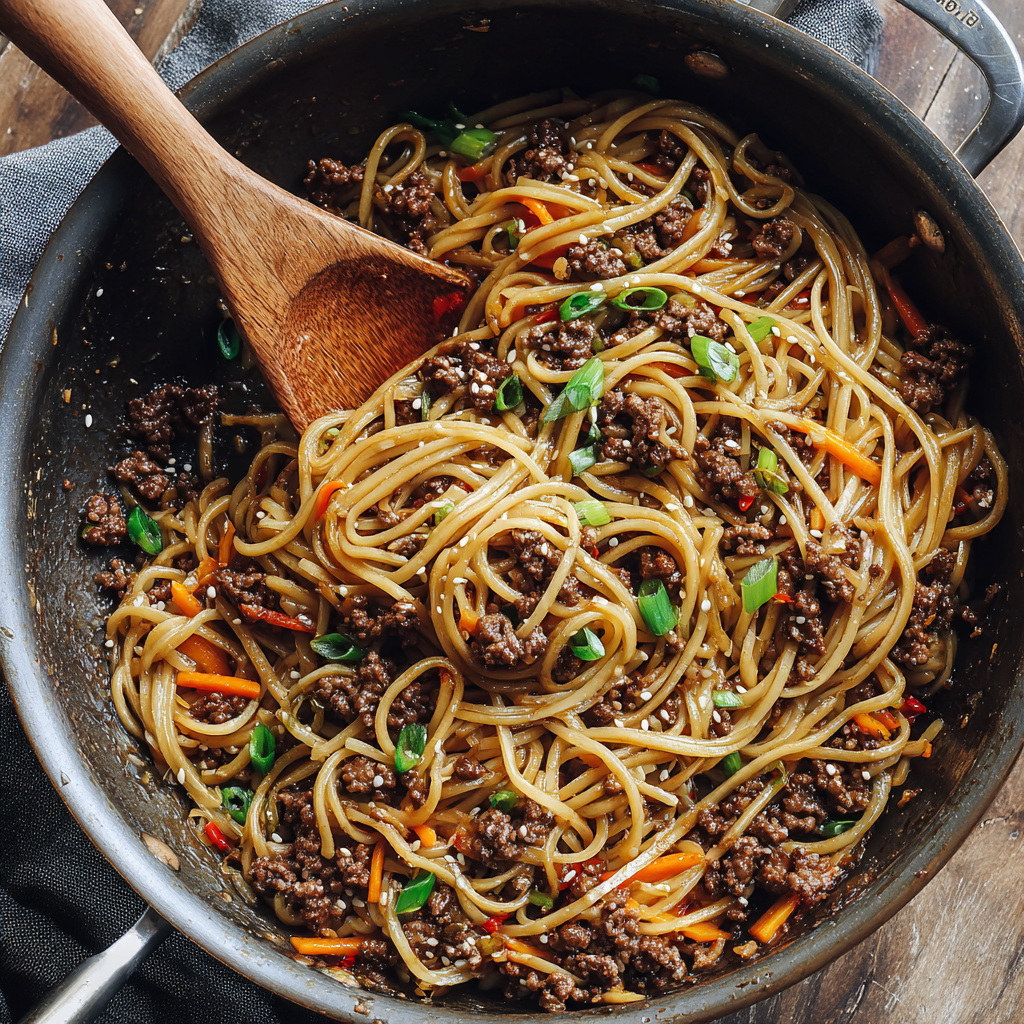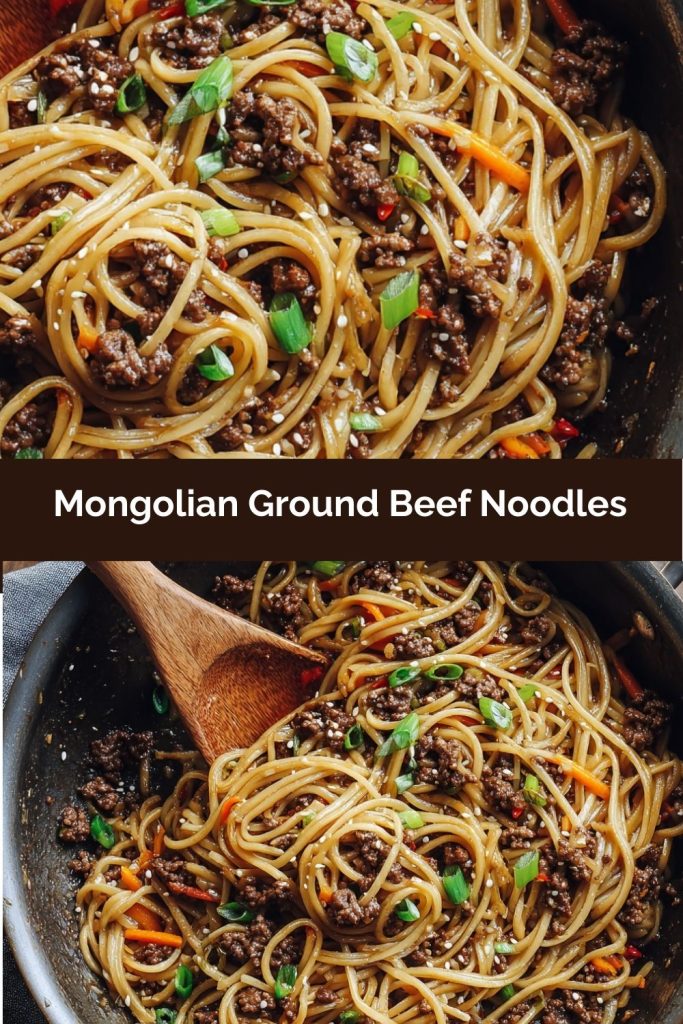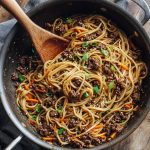***
Forget Takeout: Your New Favorite 30-Minute Meal is Here!
Hey there, friend! Let’s talk about one of those magical kitchen moments we all dream of. You know the one: it’s been a long day, your stomach is starting to rumble, and the siren call of the takeout menu is getting louder by the second. But then… you remember you have a secret weapon. A recipe that’s faster than delivery, more satisfying than waiting, and so incredibly delicious it feels like a treat. That, my friend, is the power of these Mongolian Ground Beef Noodles.
This dish is my absolute go-to when I need a big, bold flavor hug without a big, complicated process. We’re talking tender ground beef simmered in a sauce that’s the perfect trio of sweet, salty, and savory, all tossed with comforting noodles. It’s a one-pan wonder (okay, plus a pot for the noodles, but that’s it!) that delivers restaurant-quality satisfaction right from your stovetop. It’s the kind of meal that makes you feel like a kitchen hero, and I’m so excited to share it with you. So, let’s put that takeout menu back in the drawer and cook up something amazing together!
The Night We Fell in Love with a Wok
PrintMongolian Ground Beef Noodles
Take your taste buds on a trip with this Mongolian-inspired noodle dish that delivers bold flavor with minimal effort. Tender ground beef is simmered in a rich, garlicky soy-based sauce, then tossed with noodles for a quick and comforting meal. Sweet, salty, and slightly spicy—this one-pan dinner brings takeout-style satisfaction straight to your kitchen.
- Prep Time: 10 minutes
- Cook Time: 15 minutes
- Total Time: 25 minutes
- Yield: 4 1x
Ingredients
1 lb ground beef
8 oz noodles (lo mein, spaghetti, or ramen)
1/4 cup low-sodium soy sauce
2 tablespoons brown sugar
2 tablespoons hoisin sauce
1 tablespoon sesame oil
3 cloves garlic, minced
1 teaspoon grated fresh ginger (or 1/2 tsp ground ginger)
1/2 teaspoon crushed red pepper flakes (optional)
2 green onions, sliced (plus extra for garnish)
1 tablespoon cornstarch mixed with 2 tablespoons water (optional, for thickening)
Instructions
Cook noodles according to package instructions. Drain and set aside.
In a large skillet, cook ground beef over medium-high heat until browned. Drain excess fat.
Add garlic, ginger, and red pepper flakes. Cook for 1 minute until fragrant.
Stir in soy sauce, brown sugar, hoisin, sesame oil, and green onions.
If a thicker sauce is desired, add the cornstarch slurry and simmer for 2–3 minutes.
Toss cooked noodles into the skillet until well coated in sauce.
Garnish with extra green onions and serve hot.
Nutrition
- Calories: 470
- Fat: 22g
- Carbohydrates: 40g
- Fiber: 2g
- Protein: 25g
This recipe has a special place in my heart because it reminds me of a hilariously chaotic “fakeaway” night we had a few years ago. My husband and I were determined to recreate our favorite Mongolian beef takeout dish, but we were fresh out of flank steak. What we did have was a package of ground beef and a serious craving. Necessity, as they say, is the mother of invention!
I’ll be honest, that first attempt was… experimental. The sauce was a little too salty, I may have overdone the ginger, and I’m pretty sure I used far too many red pepper flakes (we like it spicy!). But as we sat there, slurping up these saucy, beefy noodles, we knew we had stumbled onto something special. It wasn’t the fancy restaurant dish we’d set out to make, but it was something even better: a quick, easy, and utterly craveable weeknight dinner that was all our own. Now, it’s a regular in our rotation, a recipe that has been tweaked and perfected with love, and it always brings a smile to our faces. It’s proof that the best kitchen memories often come from the happy accidents!
Gathering Your Flavor Arsenal
One of the best things about this recipe is how simple the ingredient list is. You probably have most of these pantry staples already! Here’s what you’ll need to create this flavor masterpiece.
- 1 lb ground beef: I like to use an 80/20 blend for the best flavor, but leaner beef works great too! For a lighter option, you can easily swap in ground turkey or chicken.
- 8 oz noodles: The canvas for our masterpiece! Lo mein noodles are classic, but spaghetti works perfectly in a pinch. For a fun twist, try using ramen noodles (just ditch the seasoning packet!).
- 1/4 cup low-sodium soy sauce: This is the salty, umami backbone of our sauce. Using low-sodium lets us control the salt level. For a gluten-free version, simply use tamari or a certified gluten-free soy sauce.
- 2 tablespoons brown sugar: This brings the essential sweetness that balances the soy sauce. Light or dark brown sugar works—dark will give a slightly deeper, molasses-like flavor.
- 2 tablespoons hoisin sauce: My secret weapon! Hoisin is a sweet and tangy Chinese sauce that adds incredible depth and complexity. If you don’t have any, you can substitute with more soy sauce and a touch of honey or oyster sauce.
- 1 tablespoon sesame oil: Oh, that nutty, toasty aroma! A little goes a long way. Make sure you’re using toasted sesame oil for cooking, not the light-colored, cold-pressed kind.
- 3 cloves garlic, minced: Fresh is best here! That punch of garlic is non-negotiable for authentic flavor. In a real pinch, ¾ teaspoon of garlic powder can work.
- 1 teaspoon grated fresh ginger: This adds a bright, zesty kick that cuts through the richness. I keep a knob of ginger in my freezer and just grate it frozen—no peeling needed! You can use ½ teaspoon of ground ginger if that’s all you have.
- 1/2 teaspoon crushed red pepper flakes (optional): This is your dial for heat! Start with a little if you’re sensitive, or add more if you like a good kick. Feel free to omit it entirely for a mild dish.
- 2 green onions, sliced: We’ll use both the white and green parts for a mild onion flavor and a pop of color. Save the green tops for a fresh garnish!
- 1 tablespoon cornstarch mixed with 2 tablespoons water (optional, for thickening): This is our “slurry.” It’s your best friend for transforming a thin sauce into a luxurious, glossy glaze that clings perfectly to every noodle.
Let’s Get Cooking: Your Step-by-Step Guide
Ready to see how quickly this all comes together? Follow these steps, and you’ll be eating in no time. I’ve packed in all my best tips and little chef hacks to ensure your success!
Step 1: Noodle Duty. Cook your chosen noodles according to the package directions. My pro tip? Cook them until they are just al dente (still have a slight bite). They’re going to hang out in the sauce for a minute later, and we don’t want them to get mushy. Once they’re done, drain them and give them a very light drizzle of neutral oil (like avocado or canola) to prevent sticking. Set them aside—they’re ready for their saucy destiny.
Step 2: Brown That Beef. While your noodles are cooking, place a large skillet or wok over medium-high heat. Add the ground beef and break it up with a wooden spoon or spatula. Cook it until it’s beautifully browned and no pink remains. This is where we build our first layer of flavor! Once it’s cooked, carefully drain off any excess fat. I like to tilt the skillet and use a spoon to remove it, or you can push the beef to one side and blot it with a paper towel.
Step 3: The Aromatics Awaken. Now, for the magic! Reduce the heat to medium. To the browned beef, add the minced garlic, grated ginger, and those optional red pepper flakes. Now, lean in and take a big whiff. Cook this for just about 60 seconds—until it’s incredibly fragrant. Be careful not to burn the garlic! This quick step unlocks all the essential oils and flavors in the aromatics, which forms the soul of our sauce.
Step 4: Build the Sauce. It’s time to bring it all together! To the skillet, add the low-sodium soy sauce, brown sugar, hoisin sauce, sesame oil, and the sliced green onions (remember to save some green tops for garnish!). Give it all a really good stir, making sure the brown sugar is fully dissolved and everything is beautifully combined. Let it come to a gentle simmer. You should see those bubbles popping and smell the most incredible savory-sweet aroma filling your kitchen.
Step 5: Thicken to Perfection (The Optional but Recommended Step). Do you want a sauce that lovingly coats each strand of noodle? Then this step is for you! In a small bowl, mix your tablespoon of cornstarch with two tablespoons of cold water until it’s completely smooth—this is your slurry. While the sauce is simmering, pour the slurry in and stir constantly. Almost instantly, you’ll see the sauce begin to thicken and turn glossy. Let it bubble away for another 2-3 minutes to cook out the starchy taste. If you prefer a thinner, more brothy sauce, you can absolutely skip this step!
Step 6: The Grand Finale—Toss It All Together! Here comes the best part! Add your drained, cooked noodles directly into the skillet with that glorious sauce. Using a pair of tongs or two forks, toss everything together until every single noodle is thoroughly coated in that sticky, savory, irresistible Mongolian beef sauce. Make sure you get right into the edges of the pan to scoop up all that goodness.
Step 7: Serve with Style. Divide the saucy noodles between bowls or plates. Finish it off with a generous sprinkle of the reserved green onion tops. For an extra bit of fun, a tiny drizzle of extra sesame oil or a sprinkle of sesame seeds right at the end is just *chef’s kiss*.
How to Serve Your Masterpiece
This dish is a complete meal in a bowl, but I love to serve it with a few simple sides to make it feel extra special. A quick, crunchy cucumber salad or a handful of lightly steamed broccoli florets tossed right in are fantastic for adding a fresh, crisp contrast. For a true restaurant-at-home experience, serve it in deep bowls with chopsticks and Asian-style soup spoons on the side for slurping up every last drop of that amazing sauce. Don’t forget a napkin—this is happily messy eating!
Make It Your Own: Delicious Twists & Swaps
The beauty of this recipe is its flexibility! Here are a few ways to switch it up:
- Veggie Lover’s Delight: Sauté some thinly sliced bell peppers, shredded carrots, or snap peas along with the ground beef for added color, crunch, and nutrition.
- Spice Explorer: Swap the red pepper flakes for a tablespoon of sriracha or a teaspoon of chili-garlic paste in the sauce for a different kind of heat.
- Low-Carb/Veggie Noodle Option: Ditch the wheat noodles altogether and serve the saucy beef over a bed of zucchini noodles (zoodles) or steamed rice cauliflower. Just be sure to salt and drain your zoodles well so they don’t water down the sauce.
- Protein Swap: Ground beef not your thing? This works wonderfully with ground pork, chicken, or turkey. For a plant-based version, use crumbled firm tofu or your favorite plant-based ground “meat.”
Anna’s Chef Notes & Kitchen Stories
This recipe has truly evolved over the years from that initial “what-do-we-have-in-the-fridge” experiment. The biggest lesson I’ve learned is the power of the cornstarch slurry—it truly transforms the dish from a simple saucy noodle into something that feels luxurious and takeout-quality. One funny kitchen story: I once accidentally used smoked paprika instead of red pepper flakes (those jars look awfully similar in a busy spice drawer!). It was… different! Not bad, but definitely a unique smoky-sweet flavor that we now jokingly call “Tex-Mongolian” Beef. The moral of the story? Don’t be afraid to play around, but maybe label your spices!
Your Questions, Answered!
Q: My sauce turned out too salty. What can I do?
A: Oh, I’ve been there! The best fix is to balance it with a touch more sweetness. Stir in an extra half tablespoon of brown sugar or a teaspoon of honey. You can also add a small splash of water or beef broth to dilute it slightly. For next time, remember that using low-sodium soy sauce is key, and be mindful that if you use a pre-made hoisin, brands can vary in saltiness.
Q: Can I make this dish ahead of time?
A: Absolutely! You can cook the beef and sauce mixture ahead of time and store it in an airtight container in the fridge for up to 2 days. When you’re ready to eat, simply reheat the sauce in a skillet, cook your noodles fresh, and toss them together. I don’t recommend storing the noodles *in* the sauce, as they will continue to absorb liquid and become very soft.
Q: The sauce didn’t thicken even after I added the slurry. What happened?
A: The most common culprit is that the sauce wasn’t at a simmer when the slurry was added. The cornstarch needs to hit hot liquid to activate its thickening power. If it’s still thin, create a new slurry with half the amount of cornstarch and water, ensure the sauce is bubbling, and try again, stirring constantly.
Q: Is there a way to make this less greasy?
A> For sure! The easiest way is to use a leaner ground beef (90/10 or 93/7). After browning, be diligent about draining the excess fat from the pan. You can also blot the cooked beef with a paper towel before adding the aromatics and sauce ingredients.
Nutritional Information*
*Please note that this is an estimate provided for informational purposes only. Actual values can vary based on specific ingredients used and any modifications made.
Per Serving (based on 4 servings): Calories: ~470 | Protein: 25g | Carbohydrates: 40g | Fat: 22g | Fiber: 2g
Prep Time: 10 minutes | Cook Time: 15 minutes | Servings: 4

Final Thoughts: Takeout Taste, Homemade Heart
At the end of the day, these Mongolian Ground Beef Noodles are proof that you don’t need a stack of takeout menus (or a hefty bill) to get big, bold flavor on the table fast. In just 30 minutes, you’ve got sweet-savory-saucy noodles tangled up with tender beef, filling your kitchen with aromas that could rival your favorite restaurant.
It’s comfort food that works as hard as you do—perfect for busy weeknights, lazy weekends, or whenever you want to impress without the stress. Whether you stick with the classic version or riff with your own veggies, proteins, or noodle swaps, this recipe is endlessly adaptable and always delicious.
So next time the takeout siren calls, remember: you’ve got the ultimate flavor hack right here in your own kitchen.
